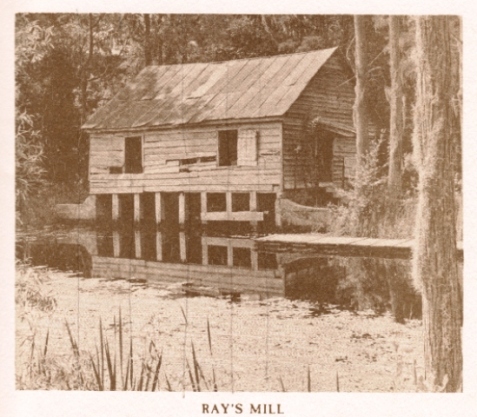In 1940s Perry Lee Pittman was a patrolman for the State Highway Department. He was renting a house on Jones Street, Ray City, GA where he lived with his wife, Inez, and their minor children: Howard Pittman, Tommy Pittman, Johnny Pittman, Meredith Williams, and Cyril Williams. He was a son of Louranie W. “Rainey” Register and John Edward Pittman. He was born in Clinch County, GA and lived for many years in Berrien County, GA.
Perry L. Pittman served as the State Representative from Berrien County, GA, and was noted for his opposition to the Georgia Constitutional Amendment that violated the voting rights of African-Americans in Georgia.

Perry L. Pittman, July 14, 1949, Chaplain of the American Legion, Otranto Post No. 115, Berrien County, GA. Image courtesy of berriencountyga.com
Perry L. Pittman was dedicated in service to his country and community. He was a Ray City veteran of World War I, a teacher, law enforcement officer, and state legislator. He was active in the American Legion and other civic organizations, and a member of the Primitive Baptist faith.

Perry L. Pittman, the State Representative from Ray City, GA.
Atlanta Constitution
February 20, 1941
Representative P. L. Pittman of Berrien.
A representative for a decade, Perry L. Pittman now knows just what makes the wheels behind the law-making body of Georgia turn. He’s a teacher and a farmer and for 18 years has taught in the rural section. A World War veteran who is most interested in education and agriculture, he is staunchly opposed to the grandfather clause. He believes in economy and hopes to curtail expenditures whereby all past obligations may be paid in full and old people may receive their benefits through pensions. He thinks pensions should be equally divided among the blind, cripple, and the dependent. The solon is 42, married, the father of four daughters and one son.
THE GRANDFATHER CLAUSE
The Grandfather Clause was part of Georgia’s 1908 Disfranchisement Constitutional Amendment , an amendment to the Georgia Constitution that was written specifically to prevent African-Americans from voting in Georgia. It worked by requiring voters to pass certain tests before they would be allowed to vote, but if your grandfather fought in the Civil War you were exempt from the tests. According to the Georgia Info website:
In 1906, Hoke Smith campaigned for governor on a progressive platform — but one that championed disfranchisement of Georgia’s black voters. To accomplish this, Smith supported a constitutional amendment that provided that any male at least 21 years of age wanting to register to vote must also: (a) be of good character and able to pass a test on citizenship, (b) be able to read and write provisions of the U.S. or Georgia constitutions, or (c) own at least 40 acres of land or $500 in property. However, any Georgian who had fought in any war from the American Revolution through the Spanish-American War was exempted from these additional qualifications. More importantly, any Georgian descended from a veteran of any of these war also was exempted. Because by 1908, most white Georgia males were grandsons of Confederate veterans, this exemption became known as the “grandfather clause.” Essentially, the qualifications of good character, citizenship knowledge, literacy, and property ownership applied only to blacks wanting to register to vote.
Georgia’s Grandfather clause remained in effect until it was struck down by the federal Voting Rights Act of 1965.

Perry Lee Pittman was sworn in as Chaplain of the American Legion Otranto Post 115 (Berrien County, GA) in July 1947, along with other officers. Image and original caption (below) courtesy of http://www.berriencountyga.comAmerican Legion Officers, July 1947
The Georgia Legionnaire, August 1947
photo caption:
NEW OFFICERS FOR OTRANTO – Georgia Department Commander of the American Legion, W.E. Burdine (left), installed new officers of Otranto Post 115 (Berrien County) July 7 and is shown congratulating Fred T. Allen, post commander. Looking on are: E.A. Alexander, historian; P.L. Pittman, chaplain. Back row, left to right: Bennie L. Tygart, vice-commander; A.D. Harnage, sergeant-at-arms; Bayne Griffin, finance officer; R.E. Williams, adjutant. (Photo by Jamie Connell)
From Ray City, the Pittmans moved to Nashville, GA. Later they would live in Homerville, GA and Valdosta, GA.

Perry L. Pittman & family move to Clinch County
Clinch County News
February 13, 1953.
Perry L. Pittman and Family Move Here from Nashville
Mr. and Mrs. Perry L. Pittman and family have moved here [Homerville, GA] from Nashville. A few days ago Mr. Pittman bought the new home recently build in Hodges Gary subdivision from Mr. A. C. Colley. He is a field agent with the State Revenue Department, Sales tax Division working in Clinch, Lanier, Echols and Charlton Counties. Mr. Pittman was born in Clinch County, but has spent most of his life in Berrien County. He taught school for over 20 years and has served in both houses of the state legislature, from Berrien County. He has been active in the American Legion and other civic organizations in Nashville and is a member of Long Bridge Primitive Baptist Church.
Children of Perry Lee Pittman and Annie Jewell Fountain (1900 – 1934)
- William Arthur Pittman (1921 – 1945)
- Thomas Pittman (1924 – )
- Perry Howard Pittman (1927 – 1995)
- John Wesley Pittman (1933 – )
Children of Perry Lee Pittman and Vida Inez Webb (1905 – )
- Meredith Williams (1925 – )
- Fred J. Williams (1927 -)
- Cyril Williams (1932 – )
- Glenda Faye Pittman (1939 – )
Related Posts:










